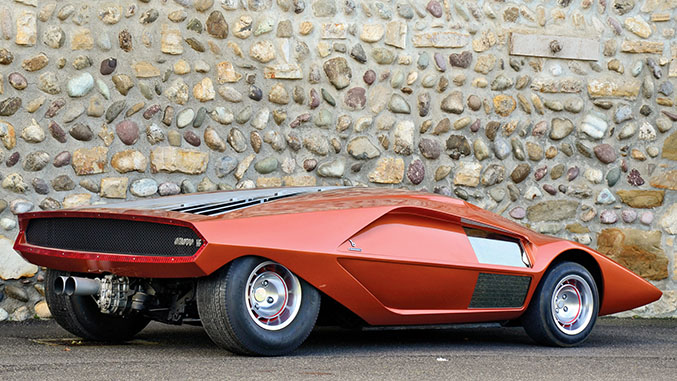The Alfa Romeo Carabo concept was presented at the 1968 Paris Motor Show. It featured a wedge-shaped body that prefigured many concepts built in the early 1970s, and it was one of the very first cars equipped with scissor doors.
Under the skin, the Carabo used the same chassis and mid-mounted 230-horsepower 2.0-liter V8 engine as the 33 Stradale. It remained a one-off design study that was never given the green light for production, but the novel scissor doors were found on several of the designer’s subsequent creations.
Like the Carabo, the Alfa Romeo Montreal stated life as merely a design study built for the 1967 International and Universal Exposition that took place in Montreal, Canada. The coupe was well-received by the show-going public and auto journalists all around the world so Alfa Romeo gave it the green light for production.
The regular-production Montreal boasted roughly the same silhouette as the concept that bowed in Canada but it featured minor visual modifications such as a redesigned front fascia with a
NACA duct on the hood and smaller tail lamps. More importantly, the concept’s 2.0-liter four-cylinder engine was tossed out in favor of a potent 2.6-liter V8 rated at about 200 horsepower.
BMW’s New Class cars are often credited for transforming the Munich-based automaker into a major player in the global auto industry and one of Mercedes’ fiercest rivals. The New Class cars were popular in the United States, and research showed buyers wanted a powerful sedan that was comfortable enough to take on long trips but smaller than the E9 Bavaria.
BMW responded with the first 5-Series in 1972. Designed with input from Gandini, the E12 5 looked like a visual evolution of the larger Bavaria but it also drew inspiration from the 2002 coupe. The shark-nosed E12 5-Series helped define the design language that BMW used for years to come.
Marcello Gandini worked with engineer Paolo Stanzini to design the Bugatti EB110, a technologically-advanced coupe that revived one of the most prestigious nameplates in automotive history. The EB110 rode on a highly-advanced carbon fiber chassis developed by a French company called Aérospatiale that specialized in building light aircrafts.
Gandini fitted the EB110 with his signature scissor doors from the earliest days of the project. The final design was fine-tuned by other stylists, and the car was introduced to the public in 1991. Although the EB110 was a mechanical masterpiece on paper, Bugatti went bankrupt several years later and returned to the history books until the company was purchased by Volkswagen in 1998.
Gandini is best-known for expensive and highly-exclusive sports cars, but he occasionally worked on more down-to-earth economy sedans like the Citroën BX. Built from 1982 to 1994, the BX was positioned in the middle of the Citroën lineup between entry-level cars like the tiny AX hatchback and the range-topping CX. Its body was noticeably inspired by the Reliant FW 11 and the Volvo Tundra, concepts designed by Gandini in 1977 and 1979, respectively.
Citroën sold over two million examples of the BX. It was designed for the European market and never offered in the United States but its angular body raised eyebrows across the Atlantic shortly after its launch. NASA reportedly bought an early BX finished in a striking shade of red and imported it to the United States in order to study how such a boxy car could boast a drag coefficient of 0.34.
Claudio Zampolli founded Cizeta in 1988 to create a world-class sports car capable of rivaling machines built by the most famous manufacturers in the industry. Commissioned by Zampolli, Gandini designed a highly-futuristic car that seemingly borrowed styling cues from both the Lamborghini Diablo and the Pininfarina-designed Ferrari Testarossa.
Unveiled in 1991, the Cizeta V16T was fitted with a 64-valve V16 engine that sent approximately 560 horsepower to the rear wheels via a five-speed manual transmission.
The Fiat X1/9 traces its roots to the Gandini-designed Autobianchi Runabout concept that was built by Bertone in 1969. The Fiat-owned Autobianchi brand was not interested in adding the roadster to its catalog of models, but Fiat’s Gianni Agnelli liked the idea of replacing the aging Fiat 850 Spider with a sporty Runabout-like two-seater.
The X1/9 was introduced in Europe in 1972. Fiat stopped production a decade later, but Bertone continued to build the car until 1989 because it was still in hot demand in the United States.
The Lamborghini Miura is one of Gandini’s best-known designs, and undoubtedly one of the most iconic sports cars of the 1960s. Its fluid lines were accented by pop-up headlights that it shared with the Fiat 850 Spider and louvers that ran across the wide rear window.
Design aside, the Miura is hailed as one of the first modern supercars because its 3.9-liter V12 was mounted transversally in the engine bay. Interestingly, the setup is said to have been inspired by the Mini Cooper that one of Lamborghini’s employees drove in the early 1960s.
The Lamborghini Countach was designed as a successor to the Miura, but the two cars shared almost no styling cues. The Countach wore a bold, wedge-shaped design that was unabashedly inspired by many of the concepts that Gandini drew in the late 1960s and early 1970s.
Although the Countach’s silhouette shocked the public and the press when it was introduced in 1974, its chiseled lines continue to influence Lamborghini’s design team today.
The Lancia Stratos was previewed by a highly-futuristic concept car called Stratos Zero that was first shown to the public in 1970. Somewhat surprisingly, Lancia liked the concept and company executives commissioned Bertone to build a more realistic version of it that could be entered in FIA-sanctioned races with only minimal modifications.
The Lancia Stratos HF prototype was shown at the 1971 Turin Motor Show, and the Stratos debuted the following year with a Ferrari-sourced V6 engine under the decklid. Largely hand-built, the Stratos went on to become one of the most successful – and desirable – rally cars of all time.
























